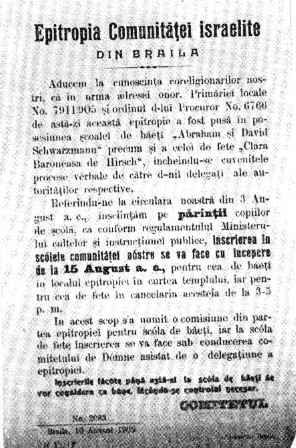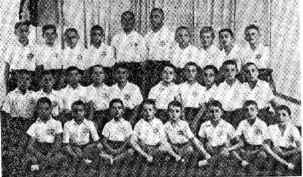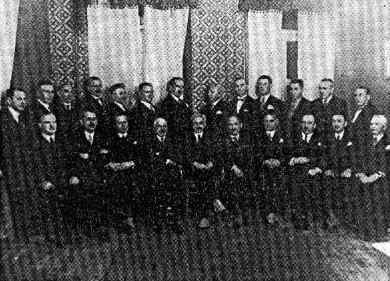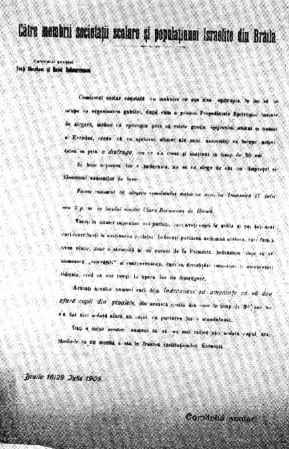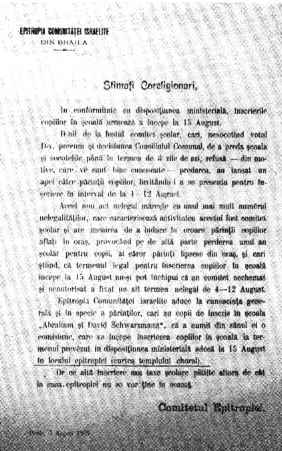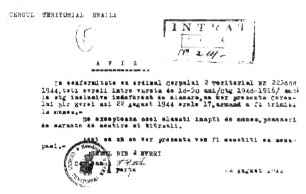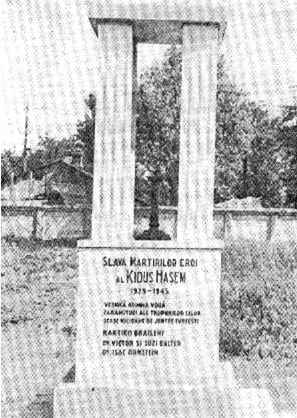(Page 84)
Brăila, Romania (cont.)
|
|
|
|
An announcement from the communal council
of the decision of the city council and the district solicitor
to transfer the two schools, for girls and boys,
to the supervision of the community
From the collection of the general archives of the history of Israel.
Translator's note: in Romanian |
|
A group of youths from the
Maccabee sports organization |
The journalist Rotman-Rolea was arrested during one of the anti-Jewish actions on the pretext of publishing articles denigrating anti-Semites. He was tortured in jail and died there.
Between the Two World Wars
After the granting of emancipation in 1918, 376 Jews of Brăila received rights of citizenship. In 1919, such rights were granted to 1,904 additional Jews. From 1920 until the ascent of Goga-Cuza to power, there were Jewish members on the city council. Five Jews served on the council in 1930 and 1932. Communal institutions and Jewish organizations even received special allocations from the city hall budget. Among others, allocations were given to the school, the soup kitchen, the Jewish students' organization, the Bnai Brith chapter, WIZO, and the Nordau-Derera Library.
After the war, the Zionist organization was reorganized, with 700 members. In the election to communal leadership of 1920, the list of the Zionist movement received most of the votes. During this era, a chapter of the Maccabee Sports Organization was also founded. Starting from 1926, the publication “News of the Zionist Organization of Brăila” was also published.
In the parliamentary elections of 1931, the Jewish Party list in Brăila received 409 votes. In 1932, it received 346.
In 1933, there was a chapter of Hashomer Hatzair there with 63 members, including 12 who went on pioneering Hachshara.
In 1937, the communal leadership included 43 members, divided into ten committees: education, religion, “Chevra Kadisha” (Burial Society), financial, aid, medicine, bathhouse, rentals, communal buildings, “Heichal” (the Great Synagogue). The community granted financial aid, winter clothing, and matzos for Passover for the needy. It also gave monthly allocations to the elderly and people unfit for work, as well as clothes to needy students and charity to itinerant beggars.
Dr. Y. Nacht and Dr. M. Thenen served in the rabbinate at that time.
On the eve of the outbreak of the Second World War, the community had five synagogues and two Beis Midrashes (study halls).
During the first years after the emancipation, anti-Semitism was barely felt in the city. At times, when the students attempted to foment disturbances in 1922 and 1923, the police and government prevented them from carrying out their plans. In 1925, when a group of anti-Semites demanded the removal of the Jewish chairman at the general meeting of the local chapter of the Journalists' Union, the majority of the journalists rejected the recommendation, claiming that discrimination runs counter to the spirit of progress.
However, after Hitler's ascension, the anti-Semitic movement strengthened in Brăila as well. The aim of its members was to rule over the council of lawyers. One of the leaders of the movement, Nicolae Cojocaru, declared that 70% of the Jewish lawyers were Communists. He recommended the implementation of “numerus nullus” (quota system) against them. However, the anti-Semitic list lost the elections to the organization. They began incitement and disruptions of trials in which Jewish lawyers took part. The anti-Semites only succeeded in their aim in February 1938, when their proposal to remove the Jewish members received majority support.
The Jewish merchants were the first to be affected by the persecution of the Legionnaires[2]. Even before they took over the government, the city council issued a ban on
(Page 85)
|
|
The communal council between the two world wars.
In the center is Dr. A. Nestoreanu |
|
|
|
|
A dispute between the committee of the schools and the community council
regarding the transfer of the schools to the authority of the community.
Translator's note: Romanian |
(Page 86)
|
|
An order to appear for forced labor issued
one day before the beginning of the ceasefire |
the female peddlers in Brăila on August 22, 1940. On September 30, 1940, the Jewish wheat merchants were attacked. A committee headed by the vice police chief confiscated hundreds of wagons of grain that were being prepared for export at the port, and forbade the Jewish merchants from entering the port.
The terror of the Legionnaires began in November. Young Jews were arrested on the street, brought to the Legionnaires' court, cruelly tortured, and forced to sign a declaration admitting that they were Communists. Anyone who could not withstand the torture did sign and was transferred to a military court.
On November 25, the Legionnaires broke into the public bathhouse of the community and forced the person in charge at gunpoint to sign a certificate giving over all the equipment, worth 15 million Lei, to the Legionnaires. The Jewish merchants were brought to the seat of the Legionnaires, and the head of the “Economic Legion” forced them to accept a Legionnaire commissar in every store, and to pay him a monthly salary.
By order of the local authorities, the Jews of all strata – rabbis, teachers, physicians, merchants, tradesmen, etc. – were forced to clear the snow from the streets (December 1940). It was forbidden for the Jews to leave the place without special permission from the head of the local police. Searches were conducted in the Jewish houses each night to expose weapons, documents and signs of spying.
On January 8, 1941, the Jewish merchants were summoned to the police, and then transferred to the “Green House”, the seat of the Iron Guard, where a demand was issued to them to forfeit their stores. The commissars of the “Halama” severely beat anyone who objected, and removed their keys by force. The authorities, headed by the district head, were indifferent to all atrocities of the Legionnaires.
The general prosecutor of the local court, Nico Oprişan, went himself to the Legionnaire headquarters and ordered that the merchants be freed. If they were not, they would be imprisoned and liable to be tortured. Aside from him, there were a few other Romanians who helped the Jews to some degree. Colonel Buhancă saved many Jews thanks to his personal friendship with the district commander. Nedelcu P. Cherciu, a well-known Christian manufacturer, gave the community a large building to serve as a Jewish infirmary and synagogue for the Hassidim. The priest Banot helped various Jews.
The persecutions continued, however. Aside from the “loan for the peace of the country” that the Jews of Brăila were forced to pay along with all the Jews of Romania, a new contribution of 60 million Lei was imposed on them in June 1943 as their part toward the massive sum of 4 billion Lei that was imposed upon the Jews of Romania to give to the government. Among the Jews who were sentenced to many years of prison for the crime of not giving over clothing that was demanded by the government, there were two who proved through witnesses and documents that they were lacking in means. Despite this, they were sentenced to five years of prison and a huge fine.
The economic decline of the Jewish population of Brăila can be seen from the following statistics from the year 1942. There were 378 unemployed among the 563 tradesman and workers; 610 of the 715 business and manufacturing officials were fired; 204 of the 443 manufacturing and business owners were forced to liquidate their assets. 45 of the 88 practitioners of the free professions were unemployed. From among the 143 independent workers, 127 were left without any means of existence.
Forced Labor:
Arbitrary forced labor was imposed upon the Jews already during the days of the hooliganism of the Legionnaires. On August 4, 1941, in accordance with a command of the regional commander, groups of Jewish workers aged 16-60 were set up “without discrimination.” Evaders were liable to the death penalty. If anyone escaped, those remaining were liable to the death penalty. The workers were ordered to bring clothing, bricks and work tools with them.
The work groups of the Jews of Brăila worked in Făurei, Tăndărei, Vizireni, and the Turcoaica quarry. Former Jewish captains were appointed as supervisors and vice supervisors over the work groups. The Jews of Brăila were occupied with these forced labor groups until August, 1944. On August 24, 1943, a Jew of Brăila was given a life sentence of forced labor, and his property was confiscated for the crime of not showing up to forced labor. On August 22, 1944, one month before the fall of the Antonescu government, the civic authorities ordered all Jews in the district to once again present themselves for “work for public benefit.” Diguri, the commander of work group 100, composed of the Jews of Brăila, demanded that the regional office of the “Jewish center” send mats and prepare winter equipment.
At that time, the city council issued an order to sell all the property of the Jews who were sent to forced labor, on the pretext that they had not paid their taxes. The secretary of the city council, Moroianu, who also served as vice mayor, canceled the decree. He even warned the community while there was still time about the intentions of the authorities to deport all the Jews of the city to the nearby village of Pisc, and to enclose them into a ghetto there. This warning gave the leaders of the community time to work against the plan.
The commander of the gendarmes, Colonel Popa, got involved for the benefit of the forced laborers by forbidding the political police from imprisoning people fleeing from the camps. He took responsibility for the deserters upon himself, and freed them. When a group of refugees from Hungary arrived in Brăila along with a brigade of forced laborers from Transylvania, Colonel Popa sent them, accompanied by gendarmes under his command, to present themselves
(Page 87)
to the “Land of Israel Office for the Care of Hungarian Refugees” in Bucharest. He thereby saved them from being sent back to Hungary, and enabled them to make aliya to the Land of Israel.
Communal activity:
A large number of Jewish refugees from Poland arrived in Brăila at the outbreak of the war. The community opened a special office to find work for the refugees. The Jews of Brăila hosted the refugees in their homes, and families who lived in small dwellings rented hotel room on their own accounts. The Maccabee hall was turned into a large dormitory for bachelors, and the synagogues also hosted refugees.
During those days, a brigade of Jewish forced laborers from Iaşi worked in the village of Turcoaia in the district of Brăila under the command of the reserve captain Carp of Bucharest, who was sentenced as a war criminal after the war. Fourteen Jews died on account of the difficult work conditions. They were buried in a communal grave in the nearby village of Măcin. The leaders of the Brăila community heard about this incident and sent Christians there to remove the bodies of the murdered people and bring them to Jewish burial in Brăila. Thanks to the intervention of the community, the brigade of Turcoaia was transferred to Brăila. The community took them under their protection, and cared for them with dedication. Thanks to their efforts, many Jews who certainly would have died under the work conditions that pervaded in Turcoaia were saved.
A group of several hundred men who were evacuated from Ploieşti also arrived in Brăila. Their representative joined the communal leadership.
|
|
A monument to the Holocaust victims of the city
[Collection of Dr. Kramer, New York].
Translator's note: the inscription on the view of the monument
in the photograph is completely in Romanian. |
Due to the economic crisis, the pillage of the Legionnaires, the loss of positions, the forced labor, etc., the livelihoods of many Jews weakened to the point where they required communal support. Similarly, the community had to concern itself with the Jews of the villages and towns who had been deported to Brăila. All of the communal buildings were expropriated and nationalized. The community broadened the activities of the soup kitchen, and anyone who was hungry received hot food. Food, clothing and firewood were sent to tens of people who had formerly been merchants and tradesmen. The family members of the men who had been taken to forced labor were among the first to receive assistance. The workers themselves also received food and clothing. The community infirmary functioned throughout the war. The community high school was moved to the Avraham and David Schwartzman Boys School. The Max Nordau Zionist Library moved out of the communal building and was transferred to a small room in the synagogue courtyard. Many readers frequented it. The Gordonia and Hanoar Hatzioni groups conducted Hebrew classes there and deliberated over plans for the future.
The community was active in the realm of education throughout this entire time. This can be seen from the following table:
| Year |
Number of students |
elementary
school |
gymnasium |
| 1940 |
284 |
124 |
| 1941 |
284 |
169 |
| 1942 |
224 |
161 |
| 1943 |
226 |
161 |
The community infirmary gave medical assistance to the following:
| Year |
Number
of
people |
| 1940 |
523 |
| 1941 |
1,441 |
| 1942 |
3,922 |
| 1943 |
962 |
From among the victims of the Jews of Brăila, we should not fail to mention Dr. Isac Leon, who had been one of the leaders of the Zionist movement in Romania even before the First World War. He immigrated to Paris on the eve of the outbreak of the Second World War. From there he was deported to Auschwitz, where he perished.
After the war, communal life continued along. For a time, the Jewish population was even larger than it was prior to the war, due to the return of the deportees who were natives of Bessarabia and primarily north Bukovina, who refused to return to their original places which were now under Soviet Rule. Later, most of them made aliya to the Land.
List of Sources
The General Archives of Israelite History - RM 46; RM 84; RM 85; RM 86; RM 87; RM 92; RM 149; RM 160; RM 162
Central Zionist Archives - A 133 (14/2,16,45/3, 93).
Yad Vashem Archives - JM 1225; 011/5-3 (3, 10, 19, 22); 011/12-I (24); 011/7-1 (3, 12, 65, 79, 114); 011/18-1 (116-27); 011/6-5; 03/902; 03/1715. PKR/I-118 (1272-89).
(Page 88)
Archives of V. Filderman - 18 (121, 129, 134-135, 177-178, 202).
Archives of M. Carp - I, 43-44; 101-02; III, 414-16; VI 129, VIII, 2.
Bibliography
Lavie, Teodor: Romanian Jewry in its Struggle for Salvation. Jerusalem, 5725 (1965), page 23.
Klausner, Yisrael: Chibat Zion in Romania. Jerusalem, 5718 (1958). Pp. 69, 73, 77, 84, 102, 144, 151, 153, 155, 161, 164, 178, 191, 193, 234, 236, 269, 270, 274, 275, 276, 279, 285, 286, 288, 289, 290, 292, 293, 294, 295, 309, 311, 312, 315, 316, 320, 321.
Derera, Nissim, E.: Monografia Comunităji Israelite din Brăila. Brăila, 1905.
Semilian, S.: Evreii in cadrul aşezării Brăilei acum 100 de ani, Brăila, 1936.
Giurescu, Constantin: Istoricul oraşulu Brăila, Bucureşti, 1968. pp. 52, 80, 82, 107.
Iorga, N.: Cei dintăi ani in noun Brăilă româncască (1932-1866), Istorie şi documente, Bucureşti, 1929. pp. 13, 62, 63, 65, 67, 69-70, 71, 72, 76, 79, 82-83, 84-85, 107, 112, 113, 114, 115, 119, 120, 122.
Popescu Mihal: Catagrafia Iocuitorilor şi a venitului din judeţul Brăila în 1828, Analele Brăilei, IV, 2-3, Brăila, 1932, pp. 61, 74.
Idem: Ibid., IV, 4, Brăila, 1932, p. 64.
Mihăilescu, Gh.: Populaţia Brăilei, Sudiu de demografie Dinamică şi statică, Analele Brăilei, IV 2-3, pp.119-124, 137.
Idem: Documente şi informaţii istorice privitoare la Brăila, Analele Brăilei,V. Brăila, 1933, pp. 72-73.
Schaffermann-Păstorescu, S.: Un capitol din istoria sportului evreesc în România,Mizug II,6,Tel-Aviv, Junie,1964.
Comunitatea evreilor din Brăila, Almanahul, Ziarului Tribuna Evreească pe anul 5698, Iaşi, 1937, pp. 266-29.
Semilian, S.: Evreii în Viaţa economică a Brăilei, Anuarul evreilor din România, Bucureşti, 1937, pp. 91-97.
Semilian, S.: Comunitatea Israelită şi Sinagoga Mareincadrul aşezării Brăileii acum o sută de ani, Curierul Israelit, Bucureşti, 14.6.1936; 21.6.1936.
Semilian, S.: Populaţia Brăilei, Cum falsifică antisemiţii statisticile, Curierul Israelit, Bucureşti 28.6.1936.
Semilian, S.: Istoricul presei brăilene de la1839 pană la 1926, Brăila, 1927, pp. 205-208.
Lapedatu, Alexandru: Evreii în ţările noastreacum o sută de ani, După relatările a doi misionari scoţieni, (Academia Románă, Memoriile secţiunei istorice, Seria III-a, Tomul XV, Mem. 8), Bucureşti, 1934, pp. 3-4).
Schwarzfeld, E.: Situaţia evreilor din Romănia, Privire retrospectivă asupra anului 1883, Anuar pentru israeliţi, VII (Bucureşti, 1884, pp. 73, 75.
Idem: Scolile publice Israelite, Egalitatea, XXII, Bucureşti, 1911, pp. 82, 179.
Nestorianu, Al, Dr.: Situaţia şcolii Israelite române în Brăila, Egalitatea,VIII, Bucureşti, 1897, pp. 238-39, 246,247.
Schwarzfeld, E.: Situaţia evreilor în Romănia, Privire retrospectivă asupra anului 1884, Anuar pentru Israeliţi, pe anul 1995, VIII, Bucureşti, 1885, pp. 111, 114, 115, 118, 131,142-43.
Cohn, Helene Hanna: Dr. H. Moskowitz, Das Jüdische Echo, München, III, 18, 5. Mai 1916.
Leon, Isac, Dr.: Dr. H Moskowitz, Hatikwa I, Nr. 20-21, Galaţi, Aprilie 1916.
Shein, Heinr. M.: Dupa moartea unui prieten, Hatikwa I, Nr. 23, Galaţi, Mai 1916.
M. S.: Dr. H. Nowcovici mort, Egalitatea, XXVI, Bucureşti, 1916, p. 107.
Ariel, Jehouda: Dr. Hermann Moscovici, Voinţa, II, Tel-Aviv, 1955, p. 196.
Magder, Ad.: Raportul Uniunei Evreilor Pământeni, Curierul Isralit, XIV, Nr. 9, Bucureşti, 1923.
Bleicher, S.: Brăila, Ostjüdische Zeitung, Gernăuţi, 13, 2, 1927.
Bercovici, Isac: Pe fiele amintirilor – Ruach Hadasch, Sliha, Tel-Aviv, 22.3.1956.
Carp, Matatias: Cartea Neagră, I, Bucureşti, 1946, pp. 65, 146,156,175, 195, 203, 257.
Pe marginea prăpastiei, I, Bucureşti, 1942, pp. 134, 224.
Filderman, W.: Memorii Lupta contra măsurilor anti-semite Sliha, I, 4, Tel-Aviv, 1956.
Costiner Lazar: Iom Kipur la Cariera de Piaträ, Un episod olmuncii obligatorii, Viaţa Evreiască, Bucureşti, 12,10,1946.
Translator's Footnote
- A term for members of the Iron Guard. Return
This material is made available by JewishGen, Inc.
and the Yizkor Book Project for the purpose of
fulfilling our
mission of disseminating information about the Holocaust and
destroyed Jewish communities.
This material may not be copied,
sold or bartered without JewishGen, Inc.'s permission. Rights may be
reserved by the copyright holder.
JewishGen, Inc. makes no representations regarding the accuracy of
the translation. The reader may wish to refer to the original material
for verification.
JewishGen is not responsible for inaccuracies or omissions in the original work and cannot rewrite or edit the text to correct inaccuracies and/or omissions.
Our mission is to produce a translation of the original work and we cannot verify the accuracy of statements or alter facts cited.
 Pinkas Hakehillot Romania: Braila
Pinkas Hakehillot Romania: Braila
 Yizkor Book Project
Yizkor Book Project
 JewishGen Home Page
JewishGen Home Page
Yizkor Book Director, Lance Ackerfeld
This web page created by Max Heffler
Copyright © 1999-2024 by JewishGen, Inc.
Updated 7 May 2011 by LA
